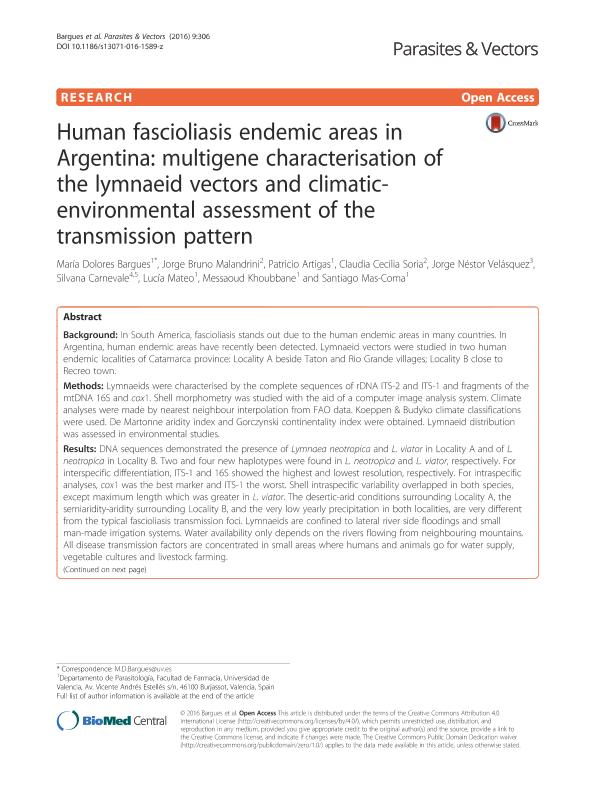Artículo
Human fascioliasis endemic areas in Argentina: multigene characterisation of the lymnaeid vectors and climatic-environmental assessment of the transmission pattern
Bargues, María Dolores; Malandrini, Jorge Bruno; Artigas, Patricio; Soria, Claudia Cecilia; Velásquez, Jorge Néstor; Carnevale, Silvana ; Mateo, Lucía; Khoubbane, Messaoud; Mas-Coma, Santiago
; Mateo, Lucía; Khoubbane, Messaoud; Mas-Coma, Santiago
 ; Mateo, Lucía; Khoubbane, Messaoud; Mas-Coma, Santiago
; Mateo, Lucía; Khoubbane, Messaoud; Mas-Coma, Santiago
Fecha de publicación:
05/2016
Editorial:
BioMed Central
Revista:
Parasites and Vectors
ISSN:
1756-3305
Idioma:
Inglés
Tipo de recurso:
Artículo publicado
Clasificación temática:
Resumen
Background: In South America, fascioliasis stands out due to the human endemic areas in many countries. In Argentina, human endemic areas have recently been detected. Lymnaeid vectors were studied in two human endemic localities of Catamarca province: Locality A beside Taton and Rio Grande villages; Locality B close to Recreo town. Methods: Lymnaeids were characterised by the complete sequences of rDNA ITS-2 and ITS-1 and fragments of the mtDNA 16S and cox1. Shell morphometry was studied with the aid of a computer image analysis system. Climate analyses were made by nearest neighbour interpolation from FAO data. Koeppen & Budyko climate classifications were used. De Martonne aridity index and Gorczynski continentality index were obtained. Lymnaeid distribution was assessed in environmental studies. Results: DNA sequences demonstrated the presence of Lymnaea neotropica and L. viator in Locality A and of L. neotropica in Locality B. Two and four new haplotypes were found in L. neotropica and L. viator, respectively. For interspecific differentiation, ITS-1 and 16S showed the highest and lowest resolution, respectively. For intraspecific analyses, cox1 was the best marker and ITS-1 the worst. Shell intraspecific variability overlapped in both species, except maximum length which was greater in L. viator. The desertic-arid conditions surrounding Locality A, the semiaridity-aridity surrounding Locality B, and the very low yearly precipitation in both localities, are very different from the typical fascioliasis transmission foci. Lymnaeids are confined to lateral river side floodings and small man-made irrigation systems. Water availability only depends on the rivers flowing from neighbouring mountains. All disease transmission factors are concentrated in small areas where humans and animals go for water supply, vegetable cultures and livestock farming. Conclusions: The unusually high number of DNA haplotypes and the extreme climate unsuitable for F. hepatica and lymnaeid development, demonstrate that the transmission foci are isolated. Seasonal transmission may depend on the timely overlap of appropriate temperature and river water availability. Lymnaeids and F. hepatica have probably reached these localities by livestock introduction. DNA differences regarding other populations of L. neotropica and L. viator in Argentina suggest an introduction independent from the spreading movements which allowed these two lymnaeids to expand throughout the country.
Palabras clave:
Fascioliasis
,
Human Infection
,
Lymnaea
Archivos asociados
Licencia
Identificadores
Colecciones
Articulos(SEDE CENTRAL)
Articulos de SEDE CENTRAL
Articulos de SEDE CENTRAL
Citación
Bargues, María Dolores; Malandrini, Jorge Bruno; Artigas, Patricio; Soria, Claudia Cecilia; Velásquez, Jorge Néstor; et al.; Human fascioliasis endemic areas in Argentina: multigene characterisation of the lymnaeid vectors and climatic-environmental assessment of the transmission pattern; BioMed Central; Parasites and Vectors; 9; 1; 5-2016; 1-20
Compartir
Altmétricas



